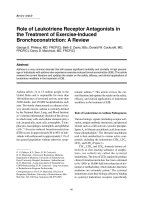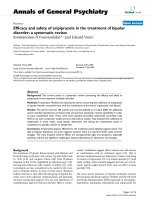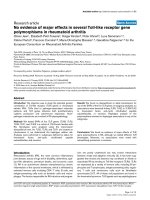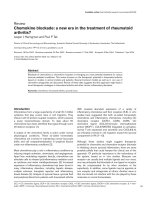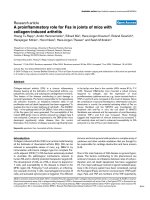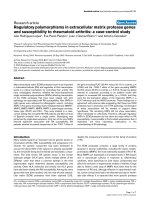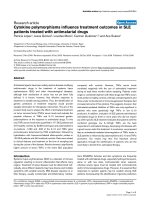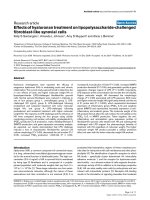Báo cáo y học: "Cytokine polymorphisms influence treatment outcomes in SLE patients treated with antimalarial drugs" ppsx
Bạn đang xem bản rút gọn của tài liệu. Xem và tải ngay bản đầy đủ của tài liệu tại đây (200.21 KB, 9 trang )
Open Access
Available online />Page 1 of 9
(page number not for citation purposes)
Vol 8 No 2
Research article
Cytokine polymorphisms influence treatment outcomes in SLE
patients treated with antimalarial drugs
Patricia López
1
, Jesús Gómez
2
, Lourdes Mozo
2
, Carmen Gutiérrez
1,2
and Ana Suárez
1
1
Department of Functional Biology, Area of Immunology, University of Oviedo. Spain
2
Department of Immunology, Hospital Universitario Central de Asturias, Oviedo. Spain
Corresponding author: Ana Suárez,
Received: 2 Nov 2005 Revisions requested: 6 Dec 2005 Revisions received: 20 Dec 2005 Accepted: 11 Jan 2006 Published: 13 Feb 2006
Arthritis Research & Therapy 2006, 8:R42 (doi:10.1186/ar1897)
This article is online at: />© 2006 López et al.; licensee BioMed Central Ltd.
This is an open access article distributed under the terms of the Creative Commons Attribution License ( />),
which permits unrestricted use, distribution, and reproduction in any medium, provided the original work is properly cited.
Abstract
Antimalarial agents have been widely used as disease-modifying
antirheumatic drugs in the treatment of systemic lupus
erythematosus (SLE) and other rheumatological diseases,
although their mechanism of action has not yet been fully
defined. It is known, however, that effective response to
treatment is variable among patients. Thus, the identification of
genetic predictors of treatment response would provide
valuable information for therapeutic intervention. The aim of the
present study was to analyze the effect of antimalarial treatment
on tumor necrosis factor (TNF)α serum levels and evaluate the
possible influence of TNFα and IL-10 functional genetic
polymorphisms on the response to antimalarial drugs. To this
end, TNFα serum levels were quantified in 171 SLE patients and
215 healthy controls by ELISA techniques and polymorphisms
at positions -1,082 and -308 of the IL-10 and TNFα gene
promoterswere determined by PCR amplification followed by
hybridization with fluorescent-labeled allele-specific probes in
192 SLE patients and 343 matched controls. Data were related
to clinical features and treatment at the time of sampling and
during the course of the disease. Results showed a significantly
higher amount of serum TNFα in the entire SLE population
compared with controls. However, TNFα serum levels
correlated negatively with the use of antimalarial treatment
during at least three months before sampling. Patients under
single or combined treatment with these drugs had TNFα serum
levels similar to healthy controls, whereas untreated patients and
those under corticosteroid or immunosuppressive therapies had
increased amounts of this cytokine. This suggests, however, that
antimalarial-mediated inhibition of TNFα was only significant in
patients who were genetically high TNFα or low IL-10
producers. In addition, evaluation of SLE patients administered
antimalarial drugs for three or more years who did not require
any other specific SLE treatment indicates that patients with the
combined genotype low IL-10/high TNFα are the best
responders to antimalarial therapy, developing mild disease with
a good course under this treatment. In conclusion, we proposed
that an antimalarial-mediated downregulation of TNFα levels in
SLE patients is influenced by polymorphisms at IL-10 and TNFα
promoters. Our results may thus find important clinical
application through the identification of patients who are the
most likely to benefit from antimalarial therapy.
Introduction
Systemic lupus erythematosus (SLE) is a disorder of immune
regulation resulting in chronic inflammation that affects many
organs. Treatment of lupus disease must be determined indi-
vidually, since different patients may have diverse and multiple
symptoms with variable severity. Mild disease requires no or
little therapy, usually nonsteroidal anti-inflammatory medica-
tions (NSAIDS). Articular and skin symptoms are frequently
treated with antimalarial drugs, especially hydroxychloroquine,
alone or with low dose corticosteroids when required,
whereas severe lupus must be treated with corticosteroids
and/or immunosuppressive drugs. However, it is assumed that
responses to specific agents may be variable among SLE
patients. Consequently, the identification of genetic predictors
CI = confidence interval; ELISA = enzyme-linked immunosorbent assay; IL = interleukin; LPS = lipopolysaccharide; NSAIDS = nonsteroidal anti-
inflammatory drugs; OR = odds ratio; PCR = polymerase chain reaction; SLE = systemic lupus erythematosus; SNP = single nucleotide polymor-
phism; TNF = tumor necrosis factor.
Arthritis Research & Therapy Vol 8 No 2 López et al.
Page 2 of 9
(page number not for citation purposes)
of treatment response would provide valuable clinical informa-
tion, since these can be determined at the time of diagnosis,
when therapeutic intervention has the potential to offer the
greatest benefits.
Antimalarial drugs (hydroxychloroquine, chloroquine and
quinacrine)have been used as disease-modifying antirheu-
matic agents in the treatment of several autoimmune diseases,
usually associated with increased secretion of pro-inflamma-
tory cytokines. However, despite an extensive clinical history of
use in rheumatoid arthritis and SLE [1], their mechanisms of
anti-inflammatory action have not yet been fully defined. Chlo-
roquine is thought to concentrate in acidic subcellular com-
partments, such as endolysosomes, where it inhibits acidic
proteases [2]. As lysosomal enzymes are involved in antigen
processing and presentation, an antirheumatic effect might be
mediated by a downregulation of the immune response
against autoantigens. However, the effects of chloroquine and
related drugs may extend beyond this. Interestingly, antimalar-
ials have been shown to inhibit the release of the pro-inflam-
matory cytokines IL-1, IL-6 and tumor necrosis factor (TNF)α
by monocytes activated with lipopolysaccharide (LPS) or CpG
oligonucleotides [3-6] and it has been reported that chloro-
quine interferes with LPS-induced expression of the gene
encoding TNFα in human blood monocytes by a nonlysosomo-
tropic mechanism [7]. However, it is not yet known whether
treatment of humans with antimalarial drugs is capable of
reducing pro-inflammatory cytokines in vivo.
Considering the central role that IL-10 and TNFα cytokines
play in the pathogenesis of SLE, it is possible that different
cytokine production may not only affect the natural course of
the disease, but also the response to therapy. Genetic poly-
morphisms at the promoter of the genes encoding IL-10 and
TNFα have been associated with different constitutive and
induced cytokine production. The genetic variant at position -
308 (G/A) of the gene encoding TNFα was found to have
functional effects on gene transcriptional activity, carriers of
the uncommon TNF2 allele (-308A*) being considered as
genetically high TNFα producers [8-10]. Similarly, IL-10 basal
and induced production presented interindividual variations
that were genetically regulated by three single nucleotide pol-
ymorphisms (SNPs) at positions -1,082(G/A), -819(C/T) and
-592(C/A) of the IL-10 promoter. In Caucasian populations,
only three haplotypes have been found (GCC, ACC and ATA),
the individuals GCC/GCC being considered as genetically
high IL-10 producers [10-12]. Several studies have analyzed
the association of IL-10 or TNFα genetic variants with suscep-
tibility to and outcome of SLE and other autoimmune diseases,
showing variable results in most cases. However, it is known
that the actions of cytokines may be profoundly conditioned by
the presence of other cytokines, this being particularly true in
the case of IL-10 and TNFα, which are mutually regulated and
have complex and predominantly opposing roles in systemic
inflammatory responses. In a previous study, we found that
carriers of the combined genotype high TNFα/low IL-10 have
the highest risk factor for developing SLE and producing anti-
bodies to the SSa antigen [10], suggesting that interactions
between IL-10 and TNF
α cytokine genes may influence sus-
ceptibility to SLE, its phenotype and possibly the clinical
response to disease modifying antirheumatic drugs. The aim of
the present study was to detect the effect of SLE treatments
on TNFα serum levels and to evaluate the possible influence
of IL-10 and TNFα functional genetic polymorphisms on the
response to antimalarial drugs.
Table 1
Systemic lupus erythematosus patient characteristics and
disease parameters
Total SLE patients 192
Sex (female/male) 178/14
Age (mean ± sd) 47.24 ± 14.63
Age at diagnosis (mean ± sd) 33.88 ± 14.53
Disease duration (mean ± sd) 13.16 ± 7.83
Clinical manifestations, n (%)
Malar rash 102 (53.1)
Discoid lesions 38 (19.8)
Subacute cutaneous lesions 33 (17.2)
Photosensitivity 99 (51.6)
Oral ulcers 63 (32.8)
Arthritis 139 (72.4)
Serositis 48 (25.0)
Renal disorder 56 (29.2)
Neurological disorder 15 (7.8)
Hematological disorder 111 (57.8)
Treatment, n (%)
None/NSAIDS 23 (12.0)
Antimalarials 114 (59.4)
Corticosteroids 126 (65.6)
Immunosuppressive drugs
a
41 (21.4)
a
Methotrexate, azathioprine, cyclophosphamide, cyclosporine A or
mycophenolate mophetil. NSAIDS, nonsteroidal anti-inflammatory
drugs; SD, standard deviation; SLE, systemic lupus erythematosus.
Available online />Page 3 of 9
(page number not for citation purposes)
Materials and methods
Patients
Approval for this study was obtained from the Regional Ethics
Committee for Clinical Investigation. Patients included in the
study (n = 192) were from the Asturian Register of SLE [13];
all of them were Caucasian in origin and fulfilled the American
College of Rheumatology (ACR) criteria for SLE [14]. At the
time of serum sampling for TNFα quantification, patients were
asked precise questions regarding the treatment received dur-
ing the past three months. All untreated or NSAID treated
patients presented inactive SLE. In addition, for genotype
associations, information on clinical manifestations (age at
diagnosis, disease duration, malar rash, discoid or subacute
cutaneous lesions, photosensitivity, oral ulcers, arthritis,
serositis, renal, neurological or hematological disorder) and
treatments followed during the course of the disease was
obtained after a detailed review of clinical histories. Those
patients receiving antimalarial agents for three or more years
without requiring any other specific treatment were defined as
good responders to antimalarial therapy. The demographic
and clinical characteristics of the patients are shown in Table
1. Matched healthy controls (n = 343) were obtained from the
Asturian Blood Transfusion Center. Consent was obtained
from all individuals prior to participation in the study.
TNFα quantification
Serum samples for TNFα quantification were collected from
171 SLE patients and 215 healthy controls. TNFα concentra-
tion was determined by an in-house ELISA test, as follows.
Microtiter wells were coated overnight with affinity purified
anti-human TNFα monoclonal antibody (R&D Systems, Abing-
don, UK) and blocked with 1% casein in Tris Buffered Saline
(TBS) for two hours at 37°C. Samples and TNFα standards
(R&D) were diluted in blocking solution and incubated for 18
hours at 4°C. After washing with TBS/Tween 20 (0.05%),
wells were incubated for two hours with biotinylated anti-
human TNF
α monoclonal antibody (R&D), washed, incubated
for one hour with streptavidin-alkaline phosphatase conjugate
and revealed using p-nitrophenyl phosphate as substrate.
Absorbance was determined at a wavelength of 405 nm.
Quantities of serum TNFα were calculated according to the
standard curves. The assay has a detection limit of 7.5 pg/ml,
a within-run imprecision (coefficient of variation) of <7%, and
a between-run coefficient of variation of <10%.
Figure 1
Antimalarial treatment downregulates tumor necrosis factor (TNF)α serum levels in systemic lupus erythematosus (SLE) patientsAntimalarial treatment downregulates tumor necrosis factor (TNF)α
serum levels in systemic lupus erythematosus (SLE) patients. TNFα
serum levels were quantified by ELISA techniques in 171 SLE patients
and 215 healthy controls. All patients were classified as users or non-
users of antimalarial drugs during the last three months before sam-
pling. Differences were evaluated by the Mann-Whitney U test.
Table 2
Tumor necrosis factor-α serum levels in healthy controls and systemic lupus erythematosus patients
n TNFα (pg/ml)
a
p
Healthy controls 215 19.66 (53.93) 0.020
SLE patients 171 33.57 (132.55)
Patient treatment:
None/NSAIDS 21 60.78 (158.15) 0.136
Antimalarials 36 16.64 (165.57)
Antimalarials and corticosteroids 54 24.95 (88.49)
Corticosteroids 26 60.01 (145.67)
Immunosuppressive drugs
b
alone or with corticosteroids 22 105.34 (195.29)
Antimalarials, corticosteroids and immunosuppressive drugs
b
12 16.89 (50.70)
a
TNFα values are median (interquartile range).
b
Methotrexate, azathioprine, cyclophosphamide, cyclosporine A or mycophenolate mophetil.
Differences were evaluated by Mann-Whitney or Kruskal-Wallis nonparametric testing. NSAIDS, nonsteroidal anti-inflammatory drugs; SLE,
systemic lupus erythematosus; TNF, tumor necrosis factor.
Arthritis Research & Therapy Vol 8 No 2 López et al.
Page 4 of 9
(page number not for citation purposes)
Promoter polymorphism genotyping
DNA was obtained from the peripheral blood cells of 192 SLE
patients and 343 local Caucasian unrelated healthy blood
donors by standard procedures. SNPs at positions -1,082 on
the gene encoding IL-10 and -308 on the gene encoding
TNFα were determined by analyzing the Tm of the probe/tar-
get duplex after PCR amplification and hybridization with fluo-
rescent-labeled probes matched with one sequence variant
(LighCycler, Roche Diagnostics, Mannheim, Germany), as
was previously reported [10]. The primers used were: 5'-ATC
CAA GAC AAC ACT ACT AAG GC and 5'-ATG GGG TGG
AAG AAG TTG AA for -1,082 IL-10 and 5'-CCT GCA TCC
TGT CTG GAA GTT A and 5'-CTG CAC CTT CTG TCT CGG
TTT for -308 TNFα. The hybridization probes (designed by TIB
MOLBIOL, Berlin, Germany) were: GGA TAG GAG GTC
CCT TAC TTT CCT CTT ACC-F and LC Red 640-CCC TAC
TTC CCC CTC CCA AA for -1,082 IL-10 and AAC CCC GTC
CCC ATG CCC C-F and LC Red 640-CCA AAC CTA TTG
CCT CCA TTT CTT TTG GGG AC for -308 TNFα.
Statistical analysis
As serum TNFα levels were not distributed normally, nonpara-
metric testing was used throughout (Mann-Whitney U test or
Kruskal-Wallis test). Correlations between TNFα concentra-
tion and clinical parameters were performed using Spear-
man's rank correlation test. TNFα values were described by
median and interquartile range. Univariate and multivariate
analyses were performed by unconditional logistic regression
to define the impact of specific single or combined functional
genotypes on the response to antimalarial treatment, calculat-
ing odds ratios (ORs) and 95% confidence intervals (95% CI).
Single-locus regression models were run to estimate the
effects of IL-10 and TNFα cytokine polymorphisms separately,
comparing the high producer genotypes with the most com-
mon low producers. A combined two-loci model was devel-
oped, including both cytokine polymorphisms to estimate
individual effects of each combined genotype, using the com-
mon low/low producer genotype as referent. Covariates for
the multivariate analyses included sex, age, disease duration
and the clinical parameters: age at diagnosis, malar rash, dis-
coid or subacute cutaneous lesions, photosensitivity, oral
ulcers, arthritis, serositis, renal, neurological or hematological
disorder. The SPSS 12.0 statistical software package (SPSS
Inc., Chicago, IL) was used for all calculations.
Results
Antimalarial treatment associates with low TNFα serum
levels in SLE patients
Quantification of TNFα levels in the serum of 171 SLE patients
and 215 healthy controls (Table 2) showed a significantly
higher amount of this cytokine in the entire patient population
compared with controls (p = 0.020, Mann-Whitney U test).
Spearman's rank correlation test did not show any significant
relationship between treatment with corticosteroids or immu-
nosuppressive drugs or the clinical features age at diagnosis,
malar rash, discoid or subacute cutaneous lesions, photosen-
sitivity, oral ulcers, arthritis, serositis, or renal, neurological or
hematological disorder and TNFα serum levels. However, a
highly significant negative correlation was detected between
the use of antimalarial drugs during at least three months
before sampling and the concentration of serum TNFα (ρ = -
0.296, p = 0.008, Spearman's test). In fact, when patients
were stratified according to treatment (Table 2), no differ-
ences were detected between controls and patients under
antimalarial treatment, either alone or combined with corticos-
teroids, whereas increased levels were observed in untreated
patients and those with corticosteroid or other immunosup-
pressive therapies. Kruskal-Wallis test analysis did not show
significant differences among treatments, probably due to the
reduced number of patients in each group after stratification.
Thus, when patients were classified as users or nonusers of
antimalarial drugs (Figure 1), we found that patients without
antimalarial treatment had significantly higher levels of serum
TNFα (median value, 61.45) than both healthy controls
(19.66, p = 0.00034) and SLE patients receiving this drug
(20.60, p = 0.008). These results suggest that antimalarial
treated SLE patients do not have the increased TNFα produc-
tion usually found in lupus patients, showing serum levels sim-
ilar to healthy controls.
Antimalarial-mediated inhibition of TNFα is associated
with TNFα and IL-10 promoter genotypes
It has been previously shown that the TNFα genotype at the -
308 position (A/G) regulates basal TNFα mRNA levels,
although no significant differences were detected in healthy
Table 3
TNFα levels in high and low TNFα producing patient users and nonusers of antimalarial treatment
TNFα genotype Healthy controls Patients without antimalarial drugs Patients with antimalarial drugs p
n
TNFα (pg/ml)
a
n
TNFα (pg/ml)
a
n TNFα (pg/ml)
a
High (AA/AG) 53 20.06 (125.63) 24 83.55 (171.64) 48 16.88 (54.89) 0.001
Low (GG) 162 18.83 (40.67) 45 58.56 (168.94) 54 26.00 (154.67) 0.516
a
Values are median (interquartile range). Differences between users and nonusers of antimalarial therapy were evaluated by the Mann-Whitney U
test. TNF, tumor necrosis factor.
Available online />Page 5 of 9
(page number not for citation purposes)
controls at the protein level [10]. To ascertain the possible
influence of this functional SNP on the association between
antimalarial treatment and decreased TNFα levels, patients
and controls were genotyped and classified as genetically
high (-308AA or AG) or low (-308GG) TNFα producers and
TNFα serum levels were evaluated in patients who used anti-
malarial drugs and those who did not (Table 3). Highly signifi-
cant differences between the two groups were detected
among high TNFα producer patients (p = 0.001), whereas no
differences between users and nonusers were observed
among genetically low TNFα producers.
It is known that the two cytokines TNFα and IL-10 are mutually
regulated and that, similar to TNFα, IL-10 levels are genetically
determined. We thus wished to evaluate the possible role of
functional IL-10 genotypes on the suggested antimalarial-
mediated TNFα downregulation. All individuals were accord-
ingly classified as high (GG) and low (AA/AG) genetic IL-10
producers by determination of the allele present at the -1,082
position. Table 4 indicates that IL-10 genotype is able to influ-
ence TNFα serum levels in SLE patients, as significant differ-
ences between users and nonusers of antimalarial treatment
were detected among low IL-10 producers (p = 0.005). No
significant variations were observed among high IL-10 produc-
ers. In conjunction, these results suggest a relationship
between antimalarial treatment and low TNFα serum levels in
genetically high TNFα and low IL-10 producing SLE patients.
This association was probably due to the high TNFα levels of
this group. In fact, when patients were classified in the four
possible combined IL-10/TNFα genotypes, we found that
TNFα serum levels in SLE patients without antimalarial treat-
ment were influenced by both cytokine polymorphisms (Figure
2). Low IL-10/high TNFα patients presented significantly
higher levels than high IL-10/low TNFα producers (93.19 ver-
sus 22.19, p = 0.018) whereas patients with balanced
cytokine production (low/low and high/high) presented inter-
mediate values (73.61 and 59.97, respectively).
Combined IL-10 and TNFα genotype influences response
to antimalarial treatment in SLE patients
Finally, in order to examine the role of IL-10 and TNFα genetic
polymorphisms as predictors of response to treatment, we
selected those patients who had been users of antimalarial
agents for more than three years without the need for any other
specific SLE therapy, thus indicating a successful response to
treatment. Among the 192 patients previously genotyped for
SNPs at both cytokine genes, we found that 40 patients
(20.83%) were good responders to antimalarial therapy
whereas another 74 (38.54%) were also users of this treat-
ment but required the combination with corticosteroids or
immunosuppressive drugs. Table 5 shows an overrepresenta-
tion of the high TNFα genotype in the good responder group.
Therefore, using logistic regression modeling, we evaluated
the influence of single and combined IL-10 and TNFα func-
tional genotypes on the response to antimalarial therapy. Table
6 shows a significant association between carriage of the high
TNFα producer genotype and good response to antimalarial
drugs (OR 2.25, 95%CI 1.11–4.58, p = 0.024), whereas the
IL-10 genotype did not show any significant association. How-
ever, when combined genotypes were analyzed, only the low
IL-10/high TNFα genotype was significantly associated (OR
3.13, 95%CI 1.41–6.92, p = 0.005). Analysis of clinical fea-
tures indicated that the group of 40 patients who were long-
term users of antimalarial drugs without requiring any other
specific treatment was characterized by lower frequency of
serositis and nephritis when compared with the remainder of
the patients (p = 0.014 and 0.003, respectively). No signifi-
cant differences were detected with respect to patient age
(46.25 ± 12.95 years versus 47.50 ± 15.07) or disease dura-
tion (12.68 ± 7.75 years versus 13.28 ± 7.86). Moreover, pre-
vious associations were sustained in the multivariate analysis
after adjusting for sex, age, disease duration and clinical
parameters. Therefore, these results indicate that, in addition
to the TNF2 allele, carriage of the low IL-10 producer geno-
type is required to become a very good responder patient to
antimalarial treatment.
Discussion
In this study we show that SLE patients receiving single or
combined treatment with antimalarial drugs have TNFα serum
levels similar to healthy controls, whereas untreated patients
and those receiving corticosteroid or immunosuppressive
therapies presented increased amounts of this cytokine.
These results suggest a very valuable effect of antimalarial
treatment by means of the downregulation of in vivo TNFα lev-
els. Although these pharmacological agents have been widely
Table 4
TNFα levels in high and low IL-10 producing patient users and nonusers of antimalarial treatment
IL-10 genotype Healthy controls Patients without antimalarial drugs Patients with antimalarial drugs p
n
TNFα (pg/ml)
a
n
TNFα (pg/ml)
a
n
TNFα (pg/ml)
a
Low (AA/AG) 179 18.55 (49.27) 56 80.88 (201.48) 79 20.94 (84.97) 0.005
High (GG) 36 21.74 (58.42) 12 51.91 (51.75) 23 20.03 (134.44) 0.797
a
Values are median (interquartile range). Differences between users and nonusers of antimalarial therapy were evaluated by the Mann-Whitney U
test. TNF, tumor necrosis factor.
Arthritis Research & Therapy Vol 8 No 2 López et al.
Page 6 of 9
(page number not for citation purposes)
used as disease-modifying antirheumatic drugs mainly in the
treatment of SLE and rheumatoid arthritis [1], their mecha-
nisms of anti-inflammatory actions have not yet been com-
pletely understood. Several in vitro experiments have
demonstrated that quinacrine and related drugs decreased
the release of pro-inflammatory cytokines induced by LPS in
macrophages [4-7,15]. In mouse models, it has been reported
that chloroquine may protect mice from lethal challenge by
CpG oligonucleotides and LPS and may decrease serum
TNFα and IL-6 in rats injected with sublethal doses of both
stimuli [16]. To the best of our knowledge, however, this is the
first report demonstrating an in vivo association between the
use of antimalarial therapy and low levels of serum TNFα, sug-
gesting that the disease-modifying antirheumatic effect of
these drugs may be mediated, at least in part, by a strong
downregulatory effect on TNFα production.
However, association between antimalarial treatment and
TNFα serum levels seems to be influenced by polymorphisms
of the genes encoding TNFα and IL-10, indicating that this
advantageous connection may only be completely valuable for
patients with a specific genotype. Constitutive and induced
TNFα and IL-10 production have important interindividual var-
iations that are genetically regulated by SNP at their promoters
[8-12]. Our data indicate that antimalarial therapy plays a role
in the TNFα production of patients who are genetically high
TNFα producers. These patients probably have the highest
TNFα transcription rates [9] and consequently the highest
serum levels. Although the mechanisms of in vitro antimalarial-
mediated TNFα inhibition [4-7] are not yet entirely known, it
has been reported that chloroquine inhibited LPS-induced
TNFα transcription [6,7], interfering with mitogen-activated
protein kinase signaling [17]. Thus, our results suggest that
antimalarial agents require a high rate of TNFα transcription to
achieve the maximal inhibitory effect. On the other hand,
though the relevance of IL-10 was already known in lupus dis-
ease, the influence of genetic polymorphisms at the IL-10 pro-
moter on treatment outcome after the use of antimalarials was
surprising. Results indicated an involvement of antimalarial
treatment in the amount of serum TNFα in SLE patients with a
low IL-10 genotype. The limited TNFα downregulatory effect
observed in genetically high IL-10 producing patients might be
explained by the regulatory feedback mechanism that controls
the production of both cytokines, which would lead to a
decrease in the TNFα transcription rate in patients producing
elevated amounts of IL-10. Supporting this, it has been
reported that high IL-10 levels were associated with less effec-
tive clearance of Plasmodium falciparum parasites in patients
receiving antimalarial therapy [18].
Table 6
Association between IL-10 and TNFα genotypes and response to antimalarial treatment
Genotype Healthy controls n (%) SLE patients Univariate analysis Multivariate analysis
a
Good responders to
antimalarials n (%)
Others n (%) OR (95% CI) p OR (95% CI) p
-1,082 IL-10
Low (AA/AG) 292 (85.1) 34 (85.0) 119 (78.8) Referent Referent
High (GG) 51 (14.9) 6 (15.0) 32 (21.2) 0.66 (0.25–1.70) 0.386 0.59 (0.20–1.78) 0.354
-308 TNFα
Low (GG) 265 (77.3) 17 (42.5) 95 (62.5) Referent Referent
High (AA/GA) 78 (22.7) 23 (57.5) 57 (37.5) 2.25 (1.11–4.58) 0.024 2.67 (1.20–5.97) 0.016
Combined IL-10/TNFα
Low/Low 224 (65.3) 12 (30.0) 75 (49.7) Referent Referent
Low/High 68 (19.8) 22 (55.0) 44 (29.1) 3.13 (1.41–6.92) 0.005 4.20 (1.66–10.63) 0.002
High/Low 41 (12.0) 5 (12.5) 19 (12.6) 1.64 (0.52–5.24) 0.400 1.77 (0.47–6.63) 0.397
High/High 10 (2.9) 1 (2.5) 13 (8.6) 0.48 (0.06–4.02) 0.499 0.43 (0.04–4.21) 0.472
Trend test 0.021 0.011
Association was calculated by unconditional logistic regression modeling using good response to antimalarial treatment as the dependent
variable.
a
Adjusted for sex, age, disease duration and clinical parameters: malar rash, discoid lesions, subacute cutaneous lesions,
photosensitivity, oral ulcers, arthritis, serositis, renal disorder, neurological disorder, hematological disorder and age at systemic lupus
erythematosus (SLE) diagnosis (continuously). CI, confidence interval; OR, odds ratio; TNF, tumor necrosis factor.
Available online />Page 7 of 9
(page number not for citation purposes)
Our data support the idea that the actions of cytokines are pro-
foundly conditioned by the presence of other cytokines, partic-
ularly in the case of IL-10 and TNFα, which have opposing
roles in systemic inflammatory responses. Thus, on the basis
of our previous results, we evaluated the role of the interaction
between IL-10 and TNFα genotypes in regulating the
response to antimalarial treatment in SLE patients. A strong
association was found between carriage of the combined gen-
otype low IL-10/high TNFα and the use of antimalarials for
more than three years without the need for any other specific
SLE treatment (good responder patients), although the single
analysis of the IL-10 genotype did not show significant results.
Moreover, the relationship between this combined genotype
and treatment outcome was higher than that obtained after
single analysis of the gene encoding TNFα, since high IL-10/
high TNFα producers were not overrepresented among good
responder patients. Taken in conjunction, these results thus
indicate that determination of TNFα and IL-10 alleles at the
onset of the disease may help identify more suitable candi-
dates for antimalarial treatment and could be used as a genetic
predictor of clinical outcome. We would expect SLE patients
who are carriers of the pro-inflammatory genotype low IL-10/
high TNFα to develop a mild disease presenting a good
course under antimalarial therapy. Most of these patients prob-
ably developed SLE due to the effect of environmental factors
added to their genetically determined high TNFα levels, which
could not be modulated by the low production of IL-10. TNFα
is a pro-inflammatory cytokine that has been found at elevated
levels in the serum of patients suffering SLE and other autoim-
mune diseases [19,20]; it has also been suggested that TNFα
genotype influences their susceptibility [10,21,22] and, possi-
bly, their clinical response to treatment. In these patients, the
elevated TNFα levels may be involved in diverse pathological
mechanisms and, therefore, a clinical benefit is to be expected
under a treatment that diminishes TNFα production.
Under the assumption that the elevated TNFα levels found in
patients with various chronic inflammatory diseases are dele-
terious, several anti-TNFα therapies are now available to block
the action of TNFα. Actually, TNFα-blockage with antibodies
has been of unquestionable clinical benefit to many patients
with rheumatoid arthritis, Crohn's disease, psoriasis and, more
recently, ankylosing spondilitis [20,23-26]. However, it has
been reported that response to this treatment is also influ-
enced by genetic polymorphisms at FcγRIII [27], HLA-DRB1
[28], lymphotoxin-α [29] and TNFα alone [30] or combined
with IL-10 [31] or lymphotoxin-α [28]. In fact, TNFα antago-
nists seem to be more effective in genetically low TNFα pro-
ducer patients [30] or with the combined high IL-10/low TNFα
genotype [31]. Several authors have also proposed the use of
Table 5
IL-10 and TNFα genotypes of systemic lupus erythematosus patients stratified by treatment
Treatment TNFα genotype IL-10 genotype
High (AA/AG) Low (GG) High (GG) Low (AA/AG)
None/NSAIDS 6 (26.1) 17 (73.9) 4 (17.4) 19 (82.6)
Antimalarials 23 (57.5) 17 (42.5) 6 (15.0) 34 (85.0)
Corticosteroids 8 (28.6) 20 (71.4) 6 (22.2) 21 (77.8)
Antimalarials and corticosteroids 25 (41.7) 35 (58.3) 16 (26.7) 44 (73.3)
Immunosuppressive drugs
a
alone or with corticosteroids 13 (48.1) 14 (51.9) 3 (11.1) 24 (88.9)
Antimalarials, corticosteroids and immunosuppressive drugs
a
5 (35.7) 9 (64.3) 3 (21.4) 11 (78.6)
Values are n (%).
a
Methotrexate, azathioprine, cyclophosphamide, cyclosporine A or mycophenolate mophetil. NSAIDS, nonsteroidal anti-
inflammatory drugs; TNF, tumor necrosis factor.
Figure 2
Combined IL-10/tumor necrosis factor (TNF)α genotype influences TNFα serum levels in SLE patients without antimalarial treatmentCombined IL-10/tumor necrosis factor (TNF)α genotype influences
TNFα serum levels in SLE patients without antimalarial treatment. After
determination of the allele present at positions -1,082 and -308 of the
IL-10 and TNFα gene promoters, respectively, patients were classified
as genetically high (GG) or low (AA/AG) IL-10 producers and high
(AA/AG) or low (GG) TNFα producers. Box plots represent TNFα
serum levels in SLE patients not receiving antimalarial therapy classified
according to the four possible IL-10/TNFα combined genotypes. Differ-
ences were evaluated by the Mann-Whitney U test.
Arthritis Research & Therapy Vol 8 No 2 López et al.
Page 8 of 9
(page number not for citation purposes)
TNFα lowering agents in the treatment of lupus disease
[20,32,33]. Supporting this, an open label study of infliximab
in six patients with SLE indicated that TNFα blockage might
have a therapeutically beneficial effect, although autoantibod-
ies to double-strained DNA and cardiolipin were increased
[34]. This trend toward an augmented autoantibody produc-
tion frequently accompanying this treatment was not reported
after the use of antimalarials. Given the therapeutical rele-
vance of these results, new studies need to be designed to
evaluate the use of these drugs as TNFα downregulators in
the treatment of genetically low IL-10/high TNFα producer
patients with SLE and other inflammatory diseases who, in
addition, are poor responders to TNFα blockage with antibod-
ies.
The limitations of the work were the lack of a prospective lon-
gitudinal study analyzing TNFα levels before and after treat-
ment with antimalarials and other SLE therapies and the
absence of standardized validated measures of SLE activity.
Conclusion
Our results demonstrate a relationship between antimalarial
treatment and low TNFα serum levels in SLE patients that
were influenced by polymorphisms at the IL-10 and TNFα
gene promoters. Therefore, our findings may have an impor-
tant clinical application through the identification of patients
who are the most likely to benefit from antimalarial therapy.
Competing interests
The authors declare that they have no competing interests.
Authors' contributions
PL performed genetic and immunological assays, data collec-
tion and statistical analyses and participated in interpretation
of data. JG carried out a detailed review of clinical histories
and participated in data collection. LM performed patient
selection and participated in data collection. CG participated
in the study design, interpretation of data and helped to draft
the manuscript. AS conceived the study, participated in its
design and coordination, performed genetic assays and statis-
tical analyses and drafted the manuscript.
Acknowledgements
The authors wish to thank ALAS (Asociación Lúpicos de Asturias) for its
continuous encouragement. Supported by Grant SV-04-FMM-01 from
the Fundación Médica Mutua Madrileña.
References
1. Rynes RI: Antimalarial drugs in the treatment of rheumatologi-
cal diseases. Br J Rheumatol 1997, 36:799-805.
2. MacIntyre AC, Cutler DJ: Role of lysosomes in hepatic accumu-
lation of chloroquine. J Pharm Sci 1988, 77:196-199.
3. Macfarlane DE, Manzel L: Antagonism of immunostimulatory
CpG-oligodeoxynucleotides by quinacrine, chloroquine, and
structurally related compounds. J Immunol 1998,
160:1122-1131.
4. Karres I, Kremer JP, Dietl I, Steckholzer U, Jochum M, Ertel W:
Chloroquine inhibits proinflammatory cytokine release into
human whole blood. Am J Physiol 1998, 274:R1058-R1064.
5. Seitz M, Valbracht J, Quach J, Lotz M: Gold sodium thiomalate
and chloroquine inhibit cytokine production in monocytic THP-
1 cells through distinct transcriptional and posttranslational
mechanisms. J Clin Immunol 2003, 23:477-484.
6. Zhu X, Ertel W, Ayala A, Morrison MH, Perrin MM, Chaudry IH:
Chloroquine inhibits macrophage tumour necrosis factor-
alpha mRNA transcription. Immunology 1993, 80:122-126.
7. Weber SM, Levitz SM: Chloroquine interferes with lipopolysac-
charide-induced TNF-alpha gene expression by a nonlyso-
somotropic mechanism. J Immunol 2000, 165:1534-1540.
8. Kroeger KM, Steer JH, Joyce DA, Abraham LJ: Effects of stimulus
and cell type on the expression of the -308 tumour necrosis
factor promoter polymorphism. Cytokine 2000, 12:110-119.
9. Wilson AG, Symons JA, McDowell TL, McDevitt HO, Duff GW:
Effects of a polymorphism in the human tumor necrosis factor
alpha promoter on transcriptional activation. Proc Natl Acad
Sci USA 1997, 94:3195-3199.
10. Suarez A, Lopez P, Mozo L, Gutierrez C: Differential effect of
IL10 and TNF{alpha} genotypes on determining susceptibility
to discoid and systemic lupus erythematosus. Ann Rheum Dis
2005, 64:1605-1610.
11. Suarez A, Castro P, Alonso R, Mozo L, Gutierrez C: Interindivid-
ual variations in constitutive interleukin-10 messenger RNA
and protein levels and their association with genetic polymor-
phisms. Transplantation 2003, 75:711-717.
12. Turner DM, Williams DM, Sankaran D, Lazarus M, Sinnott PJ,
Hutchinson IV: An investigation of polymorphism in the inter-
leukin-10 gene promoter. Eur J Immunogenet 1997, 24:1-8.
13. Lopez P, Mozo L, Gutierrez C, Suarez A: Epidemiology of sys-
temic lupus erythematosus in a northern Spanish population:
gender and age influence on immunological features. Lupus
2003, 12:860-865.
14. Tan EM, Cohen AS, Fries JF, Masi AT, McShane DJ, Rothfield NF,
Schaller JG, Talal N, Winchester RJ: The 1982 revised criteria for
the classification of systemic lupus erythematosus. Arthritis
Rheum 1982, 25:1271-1277.
15. Salmeron G, Lipsky PE: Immunosuppressive potential of anti-
malarials. Am J Med 1983, 75:19-24.
16. Hong Z, Jiang Z, Liangxi W, Guofu D, Ping L, Yongling L, Wendong
P, Minghai W: Chloroquine protects mice from challenge with
CpG ODN and LPS by decreasing proinflammatory cytokine
release. Int Immunopharmacol 2004, 4:223-234.
17. Weber SM, Chen JM, Levitz SM: Inhibition of mitogen-activated
protein kinase signaling by chloroquine. J Immunol 2002,
168:5303-5309.
18. Hugosson E, Montgomery SM, Premji Z, Troye-Blomberg M, Bjork-
man A: Higher IL-10 levels are associated with less effective
clearance of Plasmodium falciparum parasites. Parasite Immu-
nol 2004, 26:111-117.
19. Aringer M, Feierl E, Steiner G, Stummvoll GH, Hofler E, Steiner
CW, Radda I, Smole JS, Graninger WB: Increased bioactive TNF
in human systemic lupus erythematosus: associations with
cell death. Lupus 2002, 11:102-108.
20. Atzeni F, Sarzi-Puttini P, Doria A, Iaccarino L, Capsoni F: Potential
off-label use of infliximab in autoimmune and non-autoim-
mune diseases: a review. Autoimmun Rev 2005, 4:144-152.
21. Rood MJ, van Krugten MV, Zanelli E, van der Linden MW, Keijsers
V, Schreuder GM, Verduyn W, Westendorp RG, de Vries RR,
Breedveld FC, Verweij CL, Huizinga TW: TNF-308A and HLA-
DR3 alleles contribute independently to susceptibility to sys-
temic lupus erythematosus. Arthritis Rheum 2000, 43:129-134.
22. Sullivan KE, Wooten C, Schmeckpeper BJ, Goldman D, Petri MA:
A promoter polymorphism of tumor necrosis factor alpha
associated with systemic lupus erythematosus in African-
Americans. Arthritis Rheum 1997, 40:2207-2211.
23. Davis JC, van der Heijde DM, Braun J, Dougados M, Cush J, Clegg
D, Inman RD, Kivitz A, Zhou L, Solinger A, Tsuji W: Sustained
durability and tolerability of etanercept in ankylosing spondyli-
tis for 96 weeks. Ann Rheum Dis 2005, 64:1557-1562.
24. Maini R, St Clair EW, Breedveld F, Furst D, Kalden J, Weisman M,
Smolen J, Emery P, Harriman G, Feldmann M, Lipsky P: Infliximab
(chimeric anti-tumour necrosis factor alpha monoclonal anti-
body) versus placebo in rheumatoid arthritis patients receiv-
Available online />Page 9 of 9
(page number not for citation purposes)
ing concomitant methotrexate: a randomised phase III trial.
ATTRACT Study Group. Lancet 1999, 354:1932-1939.
25. Reimold AM: New indications for treatment of chronic inflam-
mation by TNF-alpha blockade. Am J Med Sci 2003,
325:75-92.
26. Suryaprasad AG, Prindiville T: The biology of TNF blockade.
Autoimmun Rev 2003, 2:346-357.
27. Tutuncu Z, Kavanaugh A, Zvaifler N, Corr M, Deutsch R, Boyle D:
Fcgamma receptor type IIIA polymorphisms influence treat-
ment outcomes in patients with inflammatory arthritis treated
with tumor necrosis factor alpha-blocking agents. Arthritis
Rheum 2005, 52:2693-2696.
28. Criswell LA, Lum RF, Turner KN, Woehl B, Zhu Y, Wang J, Tiwari
HK, Edberg JC, Kimberly RP, Moreland LW, Seldin MF, Bridges SL
Jr: The influence of genetic variation in the HLA-DRB1 and
LTA-TNF regions on the response to treatment of early rheu-
matoid arthritis with methotrexate or etanercept. Arthritis
Rheum 2004, 50:2750-2756.
29. Taylor KD, Plevy SE, Yang H, Landers CJ, Barry MJ, Rotter JI, Tar-
gan SR: ANCA pattern and LTA haplotype relationship to clini-
cal responses to anti-TNF antibody treatment in Crohn's
disease. Gastroenterology 2001, 120:1347-1355.
30. Mugnier B, Balandraud N, Darque A, Roudier C, Roudier J, Reviron
D: Polymorphism at position -308 of the tumor necrosis factor
alpha gene influences outcome of infliximab therapy in rheu-
matoid arthritis. Arthritis Rheum 2003, 48:1849-1852.
31. Padyukov L, Lampa J, Heimburger M, Ernestam S, Cederholm T,
Lundkvist I, Andersson P, Hermansson Y, Harju A, Klareskog L,
Bratt J: Genetic markers for the efficacy of tumour necrosis
factor blocking therapy in rheumatoid arthritis. Ann Rheum Dis
2003, 62:526-529.
32. Anolik JH, Aringer M: New treatments for SLE: cell-depleting
and anti-cytokine therapies. Best Pract Res Clin Rheumatol
2005, 19:859-878.
33. Smolen JS, Steiner G, Aringer M: Anti-cytokine therapy in sys-
temic lupus erythematosus. Lupus 2005, 14:189-191.
34. Aringer M, Graninger WB, Steiner G, Smolen JS: Safety and effi-
cacy of tumor necrosis factor alpha blockade in systemic
lupus erythematosus: an open-label study. Arthritis Rheum
2004, 50:3161-3169.

